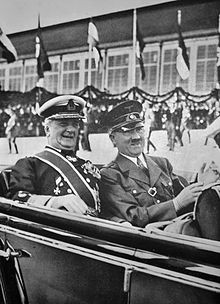
Back المجر خلال الحرب العالمية الثانية Arabic Унгария във Втората световна война Bulgarian Ungarn im Zweiten Weltkrieg German Ιστορία της Ουγγαρίας κατά τον Β΄ Παγκόσμιο Πόλεμο Greek Hungría en la Segunda Guerra Mundial Spanish Histoire de la Hongrie pendant la Seconde Guerre mondiale French הונגריה במלחמת העולם השנייה HE Magyarország a második világháborúban Hungarian Hungaria pada Perang Dunia II ID Ungheria nella seconda guerra mondiale Italian


During World War II, the Kingdom of Hungary was a member of the Axis powers.[1] In the 1930s, the Kingdom of Hungary relied on increased trade with Fascist Italy and Nazi Germany to pull itself out of the Great Depression. Hungarian politics and foreign policy had become more stridently nationalistic by 1938, and Hungary adopted an irredentist policy similar to Germany's, attempting to incorporate ethnic Hungarian areas in neighboring countries into Hungary. Hungary benefited territorially from its relationship with the Axis. Settlements were negotiated regarding territorial disputes with the Czechoslovak Republic, the Slovak Republic, and the Kingdom of Romania. On November 20, 1940, Hungary became the fourth member to join the Axis powers when it signed the Tripartite Pact.[2] The following year, Hungarian forces participated in the invasion of Yugoslavia and the invasion of the Soviet Union. Their participation was noted by German observers for its particular cruelty, with occupied peoples subjected to arbitrary violence. Hungarian volunteers were sometimes referred to as engaging in "murder tourism."[3]
After two years of war against the Soviet Union, Prime Minister Miklós Kállay began peace negotiations with the United States and the United Kingdom in autumn of 1943.[4] Berlin was already suspicious of the Kállay government, and in September 1943, the German General Staff prepared a project to invade and occupy Hungary. In March 1944, German forces occupied Hungary. When Soviet forces began threatening Hungary, an armistice was signed between Hungary and the USSR by Regent Miklós Horthy. Soon afterward, Horthy's son was kidnapped by German commandos and Horthy was forced to revoke the armistice. The Regent was then deposed from power, while Hungarian fascist leader Ferenc Szálasi established a new government, with German backing. In 1945, Hungarian and German forces in Hungary were defeated by advancing Soviet armies.[5]
Approximately 300,000 Hungarian soldiers and more than 600,000 civilians died during World War II, including between 450,000 and 606,000 Jews[6] and 28,000 Roma.[7] Many cities were damaged, most notably the capital Budapest. Most Jews in Hungary were protected from deportation to German extermination camps for the first few years of the war, although they were subject to a prolonged period of oppression by anti-Jewish laws that imposed limits on their participation in public and economic life.[8] From the start of the German occupation of Hungary in 1944, Jews and Roma were deported to the Auschwitz concentration camp. Hungary's borders were returned to their pre-1938 lines after its surrender.
- ^ Hungary: The Unwilling Satellite Archived 16 February 2007 at the Wayback Machine John F. Montgomery, Hungary: The Unwilling Satellite. Devin-Adair Company, New York, 1947. Reprint: Simon Publications, 2002.
- ^ "On this Day, in 1940: Hungary signed the Tripartite Pact and joined the Axis". 20 November 2020.
- ^ Ungváry, Krisztián (23 March 2007). "Hungarian Occupation Forces in the Ukraine 1941–1942: The Historiographical Context". The Journal of Slavic Military Studies. 20 (1): 81–120. doi:10.1080/13518040701205480. ISSN 1351-8046. S2CID 143248398.
- ^ Gy Juhász, "The Hungarian Peace-feelers and the Allies in 1943." Acta Historica Academiae Scientiarum Hungaricae 26.3/4 (1980): 345-377 online
- ^ Gy Ránki, "The German Occupation of Hungary." Acta Historica Academiae Scientiarum Hungaricae 11.1/4 (1965): 261-283 online.
- ^ Dawidowicz, Lucy. The War Against the Jews, Bantam, 1986, p. 403; Randolph Braham, A Magyarországi Holokauszt Földrajzi Enciklopediája (The Geographic Encyclopedia of the Holocaust in Hungary), Park Publishing, 2006, Vol 1, p. 91.
- ^ Crowe, David. "The Roma Holocaust," in Barnard Schwartz and Frederick DeCoste, eds., The Holocaust's Ghost: Writings on Art, Politics, Law and Education, University of Alberta Press, 2000, pp. 178–210.
- ^ Pogany, Istvan, Righting Wrongs in Eastern Europe, Manchester University Press, 1997, pp.26–39, 80–94.